Visual Tutorial
Cash Flow Statement
The statement of cash flows (or SCF) is one of the five main financial statements. It is also referred to as the cash flow statement.
The statement of cash flows covers a period of time— usually the same period as the income statement:
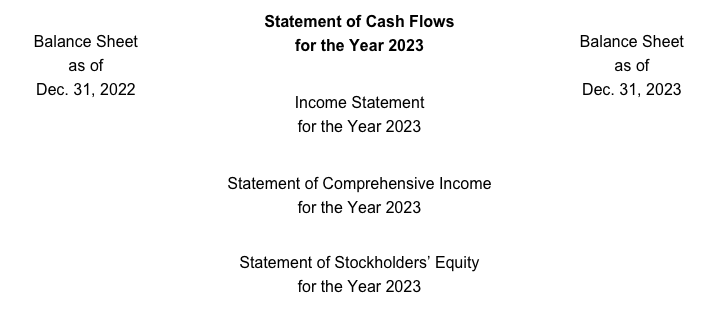
The statement of cash flows identifies the major cash inflows and outflows involved in the change in a corporation’s cash equivalents during a period of time. The period of time could be a year, quarter, month, 5 weeks, etc.
In other words, the statement of cash flows highlights the cash inflows and outflows occurring between two balance sheet dates:

Cash and Cash Equivalents
Cash includes checking accounts, checks received but not yet deposited, currency, and coins.
Cash equivalents include U.S. Treasury bills, commercial paper, and money market funds. Generally, cash equivalents must have a maturity date of three months or less at the time they are acquired.
The financial statements issued by U.S. corporations must be prepared according to generally accepted accounting principles (referred to as GAAP or US GAAP). These include very complex, detailed rules and some basic underlying principles, guidelines, and concepts such as the cost principle, matching principle, going concern assumption, conservatism, materiality, objectivity, and others.

GAAP requires that a corporation’s income statement reflect the accrual method of accounting. This means the income statement will report revenues when they are earned (which is often in an accounting period different from when the money is received).
The accrual method also means that costs must be reported as expenses on the income statement in the period in which they best match revenues or when the cost is used up. As a result, expenses are often reported on the income statement in an accounting period that is different from the period in which the cash was paid out.
Since the income statement does not report cash receipts and cash payments, the statement of cash flows is necessary for providing information on a corporation’s cash inflows and outflows.
To illustrate the need for the statement of cash flows, let’s assume that a corporation purchases a new machine on January 2, 2023 for $400,000 in cash but expenses it over a useful life of 5 years. If the corporation’s accounting year ends on each December 31 and straight-line depreciation is used, the income statement will report $80,000 of depreciation expense in each of the years 2023 through 2027. Note the differences between the time when cash is paid out and the time when the expense is reported on the income statement:

Two of the many other examples where the cash payments and/or receipts are different from the amounts reported on the income statement are:
- Cash dividends. Cash dividends to stockholders reduce cash, but they are not expenses and therefore are not reported on the income statement.
- Proceeds from the sale of an asset. If a corporation sells an old asset for $100,000 and its book value at the time was $125,000, the income statement will report a loss on disposal of $25,000. However, there is actually a cash inflow of $100,000.
There are an enormous number of cash receipts and payments occurring during an accounting period, but some of them are not revenues or expenses in that period. As a result, the income statement is not sufficient for explaining the reasons for the change in a corporation’s cash.
Now that you have seen some examples of why the income statement does not provide cash inflows and cash outflows, let’s look at the heading of the statement of cash flows.
Note that the heading begins with the corporation’s name. The second line is the name of the financial statement. The third line reports the period of time covered, which is usually the same period as the income statement.
Here’s an example of a heading for the SCF:
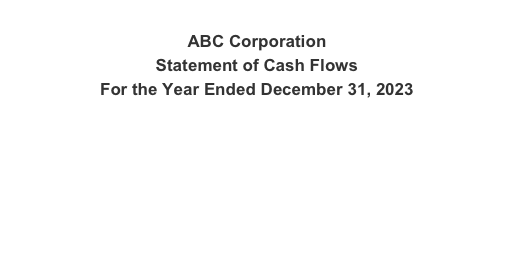
The cash inflows and outflows that reconcile the beginning and ending amounts of cash and cash equivalents are presented in three sections: operating activities, investing activities, and financing activities. The total of those three sections must agree to the change in cash and cash equivalents. Here is an outline of the statement of cash flows including the usual reference to the notes to the financial statements:
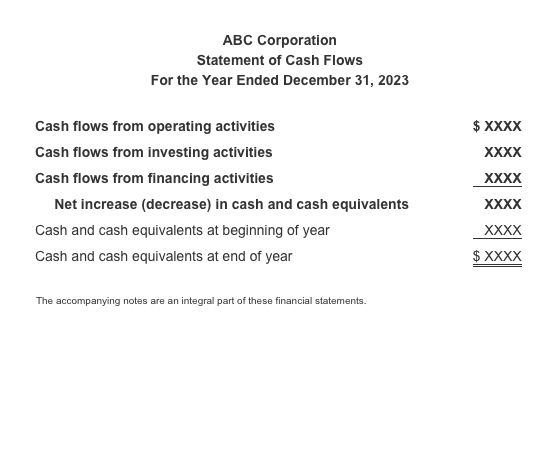
The Financial Accounting Standards Board (FASB), which establishes the reporting rules for U.S. corporations, allows for the statement of cash flows to be prepared by using either 1) the direct method, or 2) the indirect method. The FASB prefers the direct method, but nearly all major corporations use the indirect method.
This tutorial is limited to the indirect method of preparing the statement of cash flows.
Before we look at each of the three sections of the statement of cash flows, we will discuss a concept that applies to all sections:
A positive amount on the statement of cash flows indicates that:
- Cash has increased, cash was provided, cash flowed in, it was good for cash, it was positive or favorable for the corporation’s cash balance.
A negative amount on the statement of cash flows indicates that:
- Cash has decreased, cash was used, cash flowed out, it was not good for cash, it was negative or unfavorable for the corporation’s cash balance.
A concept that applies to the operating activities section and to the investing activities section is:
If an asset (other than cash) has increased, the amount of the increase is shown as a negative amount on the SCF.
For example, if inventory has increased, it is assumed that cash was used to purchase the additional inventory. The use of cash is presented as a negative amount on the SCF because the use of cash has a negative effect on the corporation’s cash balance.
An increase in an asset (other than cash) indicates that cash was used. Therefore, the amount of the increase is reported as a negative amount on the SCF.
The following concept applies to the operating activities section and to the financing activities section:
If a liability has increased, the amount of the increase is shown as a positive amount on the SCF.
For example, if accounts payable has increased, the increase indicates that the corporation did not pay all of its vendors’ invoices. Not paying some invoices is helpful for the corporation’s cash balance and will be reported as a positive amount on the SCF.
An increase in a liability means that cash was not used or that money was received when the company increased its debt. The amount of the increase in a liability is reported as a positive amount on the SCF, because it was positive for the corporation’s cash balance.
Continuing with the positive and negative amounts on the statement of cash flows (SCF):
If an asset (other than cash) has decreased, the SCF will report a positive amount. For example, if the company’s inventory has decreased, it is assumed that cash was received. If cash was received, it was positive or favorable for the corporation’s cash balance.
If a liability has decreased, the SCF will report a negative amount. For example, if a corporation reduces its bank loan, the reduction will have a negative or unfavorable impact on the corporation’s cash balance.
A decrease in an asset (other than cash) means that cash was received and that is positive for the corporation’s cash balance.
A decrease in a liability means that cash was used to pay debts and that has a negative effect on the corporation’s cash balance.
Continuing with the positive and negative amounts on the statement of cash flows (SCF):
A change in an asset amount (other than cash) will mean cash changed in the opposite direction:
- If an asset increased, cash decreased.
- If an asset decreased, cash increased.
A change in a liability amount will mean that cash changed in the same direction:
- If a liability increased, cash increased
- If a liability decreased, cash decreased
Section #1 of SCF: Cash Flows from Operating Activities
The first section of the SCF, Cash Flows from Operating Activities, presents the cash that was provided by the corporation’s operating activities. For a retailer, this means the cash from sales and purchases of goods, store rent, salaries of employees, advertising, supplies, and so on.
Under the indirect method, the cash flows from operating activities begins with the amount of net income that was reported on the income statement. Next, the amount of noncash expenses (such as depreciation) will be added to the net income amount. Third, there will be adjustments to convert the revenues and expenses from the accrual method amounts to the cash amounts.
Under the indirect method, the cash flows from operating activities will report:
- The corporation’s net income
- The noncash expenses such as depreciation
- Adjustments to convert revenues and expenses to cash amounts
Section #1 of SCF: Cash Flows from Operating Activities (continued)
Let’s assume that a corporation spent $400,000 on January 2, 2023 to purchase equipment and that it will record $80,000 of depreciation expense in each of the years 2023-2027.
Each year, the entry to record depreciation expense of $80,000 will reduce the company’s net income, but it will not reduce the corporation’s cash.
If we assume that the corporation’s income statement for one of the years reports $340,000 of net income, the SCF will begin with the following amounts:

Section #1 of SCF: Cash Flows from Operating Activities (continued)
After adding back the depreciation expense, we list the amounts that will convert the revenues and expenses from the accrual method to their cash amounts.
For example, if a corporation’s income statement and net income included sales of $950,000 but the accounts receivable increased by $40,000, there needs to be an adjustment for the $40,000 not collected.
Not collecting $40,000 of the sales hurts the corporation’s cash balance and as a result will be shown as a negative adjustment to the net income.
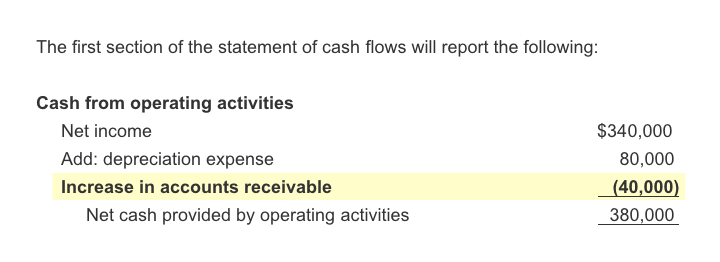
Section #1 of SCF: Cash Flows from Operating Activities (continued)
If the total of accounts receivable had decreased by $35,000 (instead of increasing by $40,000), the amount of cash collected would have been $35,000 more than the sales reported on the income statement.
Collecting $35,000 more than the sales included in the net income helps the corporation’s cash balance and as a result will be reported as a positive adjustment to the net income amount on the SCF:

Section #1 of SCF: Cash Flows from Operating Activities (continued)
Next, we will adjust expenses from the accrual amounts to the cash amounts.
For instance, if the corporation’s income statement and net income included expenses of $550,000 but its accounts payable decreased by $30,000, there needs to be an adjustment for the additional payment of $30,000.
Paying $30,000 more than the amount of expenses on the income statement hurts the corporation’s cash balance and will need to be reported as a negative adjustment to the net income amount on the SCF:

Section #1 of SCF: Cash Flows from Operating Activities (continued)
Another adjustment for expenses involves prepaid expenses. Let’s assume that the amount of prepaid insurance (a current asset) was $10,000 at the start of the year and it was $30,000 at the end of the year. The increase of $20,000 means that in addition to the insurance expense included in the net income, an additional payment of $20,000 must have been made.
Increasing the prepaid insurance by $20,000 required an additional cash outflow of $20,000. Since this hurts the corporation’s cash balance, it is reported as a negative adjustment to the net income:
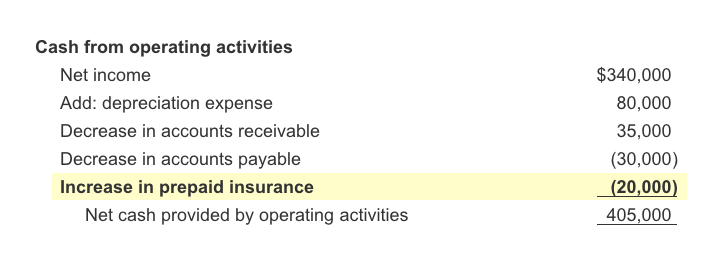
Section #1 of SCF: Cash Flows from Operating Activities (continued)
The previous page showed that the corporation’s net income was $340,000 but its cash from operating activities was $405,000. When the cash provided from operating activities is consistently greater than net income, it is interpreted to mean that the quality of the reported net income is high.
Expect the cash flows from operating activities to be greater than net income.
Section #1 of SCF: Cash Flows from Operating Activities (continued)
When the cash provided from operating activities is less than the net income, you should find the reasons for the negative adjustments. For example, if the operating activities section shows a negative amount for accounts receivable, it is telling you that the receivables have increased. You should be curious as to why. If the increase was not caused by additional sales volume, are the customers slowing their payments because of a problem with the quality of the products or services?
Negative adjustments in the operating activities section can be a sign of a bigger problem. You should determine the underlying reasons for the negative adjustments to the net income.
Section #2 of SCF: Cash Flows from Investing Activities
The second section of the SCF reports the cash inflows and outflows pertaining to noncurrent assets such as long-term investments and property, plant and equipment.
For example, if a corporation’s balance sheet shows an increase in land, buildings, equipment, vehicles, etc., it is assumed that cash was used. When cash is used, it is an outflow of cash and will, therefore, be reported as a negative amount under investing activities.
The amounts spent for property, plant and equipment are often referred to as capital expenditures and will be reported as follows:

Section #2 of SCF: Cash Flows from Investing Activities (continued)
When a long-term asset is sold, the money received from the sale/disposal will be reported as a positive amount in the investing activities section of the SCF.
To illustrate, let’s assume that a corporation sells its old delivery truck and receives cash of $20,000. Since this is a cash inflow, the amount received will be reported as a positive amount as shown below.

Section #3 of SCF: Cash Flows from Financing Activities
The third section of the statement of cash flows reports the cash inflows and the cash outflows pertaining to the corporation’s borrowings, long-term liabilities, and stockholders’ equity.
The corporation’s financing activities include:
- The proceeds from borrowing money (short-term and/or long-term loans)
- The repayment of borrowed money
- The proceeds from issuing more common and/or preferred stock
- The purchase of treasury stock
- The payment of cash dividends
Section #3 of SCF: Cash Flows from Financing Activities (continued)
When a corporation borrows money, its liabilities increase and its cash increases. In other words, the corporation will see a cash inflow. The cash inflows from borrowing money are reported as positive amounts in the financing activities section of the SCF.
When a corporation repays the money it had borrowed, its liabilities decrease and its cash decreases. The cash outflows associated with repaying loans are reported as negative amounts in the financing activities section of the SCF.

Section #3 of SCF: Cash Flows from Financing Activities (continued)
When a corporation issues shares of its stock, the paid-in capital section of stockholders’ equity increases and its cash increases. The cash inflow from issuing stock will be reported as a positive amount in the financing activities section of the SCF.
When a corporation pays dividends to its stockholders, the cash outflow is reported as a negative amount in the financing activities section of the SCF.
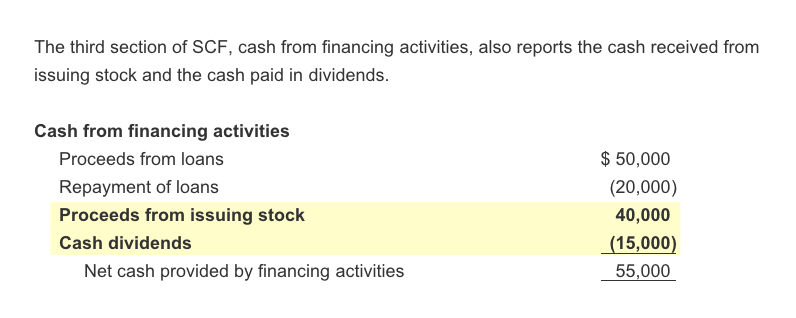
Recap of the Positive and Negative Amounts on SCF
If an asset (other than cash) has increased, it is assumed that there was a cash outflow. Cash outflows are presented as negative amounts on the SCF.
If an asset (other than cash) has decreased, it is assumed that there was a cash inflow. Cash inflows are presented as positive amounts.
If a liability has increased, it is assumed that there was a cash inflow. Cash inflows are presented as positive amounts on the SCF.
If a liability has decreased, it is assumed that there was a cash outflow to reduce the liability. Cash outflows are presented as negative amounts.
Supplemental Information to be Disclosed
Occasionally a corporation will exchange its common stock or bonds for a long-term asset. Even though the transaction did not involve cash, it must be disclosed as supplementary information.
The statement of cash flows also requires the disclosure of the amount of interest paid and the amount of income taxes paid.
For the complete reporting and disclosure requirements it is best to refer to the Financial Accounting Standards Board website FASB.org.
The End
This tutorial is merely an introduction to the statement of cash flows. Hence, not all adjustments and not all cash flows were illustrated. Further, this tutorial is not a substitute for professional accounting advice.
You can learn more about the statement of cash flows at the following topic: Cash Flow Statement.
Turn on study mode to focus
Cash Flow Statement Outline
- Read our Explanation (8 Parts) Free
- Take our Practice Quiz Free
- Review our Visual Tutorial
- Watch our Financial Statements Video Training
- Review our Flashcards
- Solve our Word Scramble Free
- Solve our Crossword Puzzle #1 Free
- Solve our Crossword Puzzle #2 Free
- Solve our Crossword Puzzle #3 Free
- Review our Sample Business Forms
- Review our Cheat Sheet
- Take our Quick Test #1
- Take our Quick Test #2 with Coaching
- Earn our Cash Flow Statement Certificate of Achievement
Learn How to Advance Your Accounting and Bookkeeping Career
- Perform better at your current job
- Refresh your skills to re-enter the workforce
- Pass your accounting class
- Understand your small business finances
Featured Review
"I am a small business accountant and tax preparer. A lot of my clients are do-it-yourself bookkeepers for their small business. Most of them, if not all, use bookkeeping software to keep track of their business. Although software programs are great at what they do and are easy for the user, the double entry accounting method is still occurring in the background. Accounting concepts and terms are not easily explained to a small business owner who doesn't understand why reports look the way they do. To help them, I always direct them to AccountingCoach to learn the concepts and terms. The tutorials, glossary, and web topics are presented in the best way that anyone can understand accounting. It's the best source on the web!" - Kathleen F.




